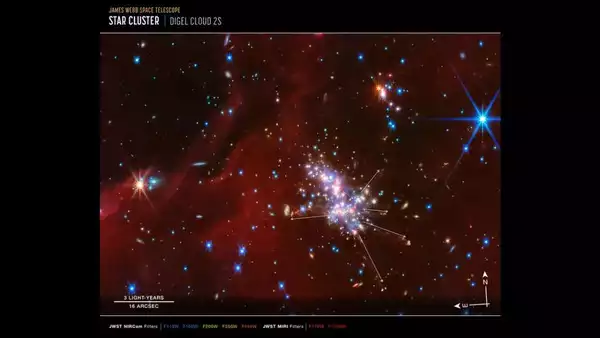The Webb Telescope has taken the exploration of the universe to the following degree, by capturing its consideration in direction of the margins of the mysterious Milky Manner Galaxy.At present, let’s discover this topic intimately, uncovering intriguing insights into what the telescope has discovered.
Uncommon observations on the fringe of the Galaxy
The latest notations of the James Webb Telescope (JWST) highlighted a singular space, referred to as the ‘Excessive Outer Galaxy’, which is located about 58,000 light-years from the middle of the Milky Manner. On your higher understanding and information- – The photo voltaic system is roughly 26,000 light-years away from the middle of the galaxy, making this assessment of the galaxy’s outer boundary. The findings have offered an immensely magnificent visible of the clusters of stars going by way of a major star formation.
Picture credit score: NASA, ESA, CSA, STScl, M. Ressler (JPL)
A contemporary viewpoint on Star Clusters
A researcher named Natsuko Izumi from Gifu College and the Nationwide Astronomical Observatory of Japan, who directed the research, revealed her enthusiasm, stating “The JWST knowledge builds upon what we now have incrementally gathered through the years from prior observations with totally different telescopes and observations. We are able to get very highly effective and spectacular photographs of those clouds with the JWST.”
The Webb Telescope’s Mid-Infrared Digicam (MIRI), in addition to Close to-Infrared Digicam (NIRCam), caught particular photos of two huge molecular clouds known as ‘Digel Cloud 1’ and ‘Digel Cloud 2’. These clouds are, in actuality, crowded areas of mud in addition to fuel, and are the areas the place younger stars are shaped. These mind-blowing photographs showcased newly shaped growing stars which can be at the moment assembling mass and never but within the stage of initiating fusion reactions.
Protostars and their dynamic expulsions
It has been noticed that the protostars are particularly energetic and vigorous, ceaselessly sending out high-intensity streams of extraordinarily scorching fuel, as they type. This incidence was vaguely caught within the Telescope photos. A scientist of NASA’s Jet Propulsion Laboratory, named Mike Ressler famous “What was fascinating and astounding to me from the JWST knowledge is that there are a number of jets capturing out in all totally different instructions from this cluster of stars. It’s a little bit bit like a firecracker, the place you see issues capturing this fashion and that.”
The insights emphasised a very energetic star-forming area that caught consideration, known as 2S in Digel Cloud 2, uncovering a situation of immensely dynamic star formation and intense vitality emissions.
Distinctive traits of the Digel Clouds
The Digel Clouds are identified to encompass an extremely distinctive and stunning association in distinction to the opposite areas of our Milky Manner Galaxy. This composition is relatively missing in parts denser than helium in addition to hydrogen, generally referred to as “metals” by house scientists. This metal-lacking side affords extremely important insights and knowledge into the start phases of stellar evolution and the traits of dwarf galaxies.

Picture credit score: NASA, ESA, CSA, STScl, M. Ressler (JPL)
Upcoming analysis instructions
The analysis workforce is getting ready to maintain going with the research of those outer areas to attain an in-depth understanding of the dynamics of star clusters in addition to star formation. Their main goal is to seek out out the rationale why stars in these far-off and remoted areas may range from the extra proximate ones to the core of the galaxy.
Izumi shared her persistent curiosity, mentioning “I’m excited about persevering with to review how star formation is going on in these areas. By combining knowledge from totally different observatories and telescopes, we are able to look at every stage within the evolution course of.”


